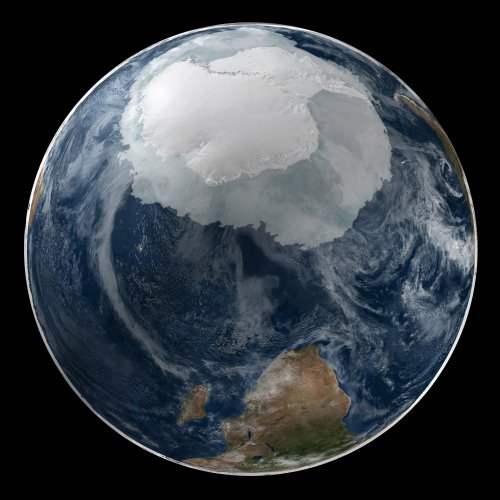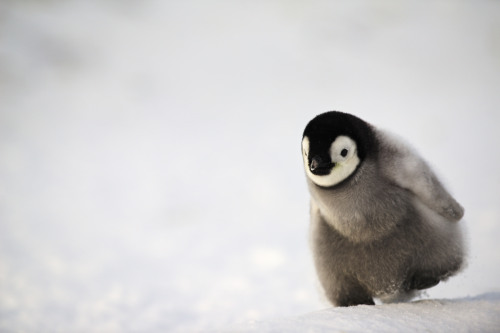#sea ice
Antarctica (September 21st, 2005). The terrain and cloud cover are taken from images in 2004 and 2002 respectively.
The Antarctic is in some ways the opposite of the Arctic. The Arctic is an ocean basin surrounded by land, whereas the Antarctic is a continent surrounded by water.
In the Northern Hemisphere, sea ice can extend southwards to a latitude of 45°N (along the north-east coasts of Asia and North America), but most of the ice is above 70°N. In the Southern Hemisphere, the ice doesn’t get that close to the South Pole. It fringes the continent, and extends northwards to 55°S at its greatest extent.
Because of this, Antarctic sea ice coverage is larger in winter than in the Arctic, but smaller in summer. Total Antarctic sea ice peaks in September (beginning of spring) to a historical extent of 17 – 20 million square kilometres. The minimum extent is in February (end of summer), at about 3 – 4 million square kilometres.
Antarctic sea ice is distributed around the entire fringe of the continent, a much broader area than in the Arctic. It is also exposed to a broader range of land, ocean and atmospheric influences. Because of this geographic and climate diversity, the Antarctic sea ice is more variable from year to year. Climate oscillations don’t affect all areas in the same way. Therefore, it is more difficult to make overall generalizations about the influence of climate patterns here.
The Antarctic Oscillation involves a large-scale “see-sawing” of atmospheric mass between the pole and mid-latitudes. This oscillation can intensify, weaken, or shift the location of low- and high-pressure weather systems. These changes influence wind speeds, temperature, and the track that storms tend to follow. Any of these things can influence sea ice extent.
During a “positive phase”, the westerly winds circling Antarctica strengthen and move southwards (inwards). This can change the way ice is distributed among the sectors. It also isolates much of the Antarctic atmosphere.
These stronger winds have an overall cooling effect, but also cause a dramatic warming on the Antarctic Peninsula. This is because warmer air above the oceans to the north is drawn southwards (inwards). In general, these winds can lessen sea ice in some areas and increase it in others, because it can drive the ice further away from the coast or closer towards it, depending on the region.
Post link
Treasureby Daniel Armbruster
Via Flickr:
An Emperor Penguin couple caring for their egg at the beginning of the Antarctic winter. Meanwhile the male animal will stay breeding the egg, the female animal will leave its partner going back to the open water.
Post link
Rocks out of place
Why are these rocks out of place? They just do not fit the environment in which they are. The sea waves that moved the medium to coarse sand that is now the sandstone that surrounds these boulders, are not strong enough to move boulders. There is a huge contrast in mass between the sand and the boulder. So, the only explanation is they were placed here by some other means. For this reason, such rocks are called ‘dropstones’, as they were dropped/placed into their current position, rather than being transported along with the surrounding sediment.
One explanation how this could have happened, is the sea ice. During Permian (~300-250 million years ago) this region was under ice age conditions, with glaciers covering the continent from land to sea. So, whether it was glaciers sliding into the sea, or sea ice enveloping loose boulders around the coast and moving them off into the sea; it is impossible to say exactly. But, because ice floats on water, it provides a good candidate for a mechanism of moving these heavy boulders from the land to the sea bypassing the sea wave transport.
Ulladulla, Australia
Post link
The Chinese ice-breaker Xue Long, as seen from the bow of the Aurora Australis, has become stuck in sea ice.
Post link
“An aerial view shows floodwaters after the ice-choked Lena River spilled its banks in remote settlements in the Sakha Republic, Yakutia, Russia, on May 13th.″ Photo: Andrey Sorokin/Sputnik/AP, accompanying thisWashington Post article.
Post link






